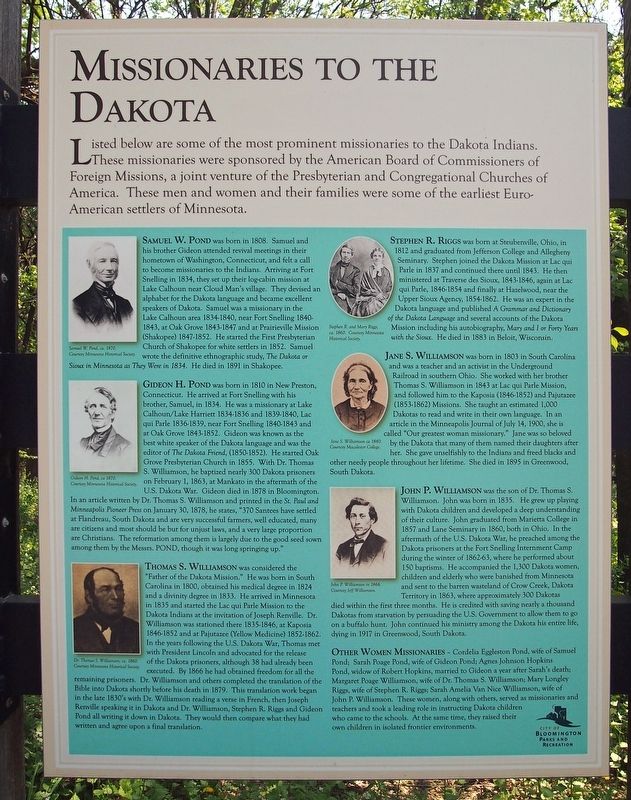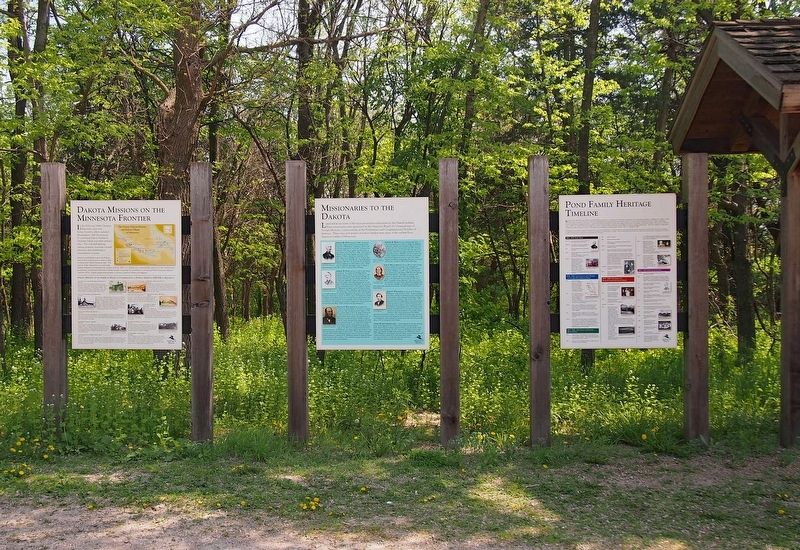East Bloomington in Hennepin County, Minnesota — The American Midwest (Upper Plains)
Missionaries to the Dakota
Samuel W. Pond was born in 1808. Samuel and his brother Gideon attended revival meetings in their hometown of Washington, Connecticut, and felt a call to become missionaries to the Indians. Arriving at Fort Snelling in 1834, they set up their log-cabin mission at Lake Calhoun near Cloud Man's village. They devised an alphabet for the Dakota language and became excellent speakers of Dakota. Samuel was a missionary in the Lake Calhoun area 1834-1840, near Fort Snelling 1840-1843, at Oak Grove 1843-1847 and at Prairieville Mission (Shakopee) 1847-1852. He started the First Presbyterian Church of Shakopee for white settlers in 1852. Samuel wrote the definitive ethnographic study, The Dakota or Sioux in Minnesota as They Were in 1834. He died in 1891 in Shakopee.
Gideon H. Pond was born in 1810 in New Preston, Connecticut. He arrived at Fort Snelling with his brother, Samuel, in 1834. He was a missionary at Lake Calhoun/Lake Harriet 1834-1836 and 1839-1840, Lac qui Parle 1836-1839, near Fort Snelling 1840-1843 and at Oak Grove 1843-1852. Gideon was known as the best white speaker of the Dakota language and was the editor of The Dakota Friend, (1850-1852). He started Oak Grove Presbyterian Church in 1855. With Dr. Thomas S. Williamson, he baptized nearly 300 Dakota prisoners on February 1, 1863, at Mankato in the aftermath of the U.S. Dakota War. Gideon died in 1878 in Bloomington. In an article written by Dr. Thomas S. Williamson and printed in the St. Paul and Minneapolis Pioneer Press on January 30, 1878, he states, "370 Santees have settled at Flandreau, South Dakota and are very successful farmers, well educated, many are citizens and most should be but for unjust laws, and a very large proportion are Christians. The reformation among them is largely due to the good seed sown among them by the Messrs. POND, though it was long springing up."
Thomas S. Williamson was considered the "Father of the Dakota Mission." He was born in South Carolina in 1800, obtained his medical degree in 1824 and a divinity degree in 1833. He arrived in Minnesota in 1834 and started the Lac qui Parle Mission to the Dakota Indians at the invitation of Joseph Renville. Dr. Williamson was stationed there 1835-1846, at Kaposia 1846-1852 and at Pajutazee (Yellow Medicine) 1852-1862. In the years following the U.S. Dakota War, Thomas met with President Lincoln and advocated for the release of the Dakota prisoners, although 38 had already been executed. By 1866 he had obtained freedom for all the remaining prisoners. Dr. Williamson and others completed the translation of the Bible into Dakota shortly before his death in 1879. The translation work began in the late 1830's with Dr. Williamson reading a verse in French, then Joseph Renville speaking it in Dakota and Dr. Williamson, Stephen R. Riggs and Gideon Pond all writing it down in Dakota. They would then compare what they had written and agree upon a final translation.
Stephen R. Riggs was born at Steubenville, Ohio, in 1812 and graduated from Jefferson College and Allegheny Seminary. Stephen joined the Dakota Mission at Lac qui Parle in 1837 and continued there until 1843. He then ministered at Traverse des Sioux, 1843-1846, again at Lac qui Parle, 1846-1854 and finally at Hazelwood, near the Upper Sioux Agency, 1854-1862. He was an expert in the Dakota language and published A Grammer and Dictionary of the Dakota Language and several accounts of the Dakota Mission including his autobiography, Mary and I or Forty Years with the Sioux. He died in 1883 in Beloit, Wisconsin.
Jane S. Williamson was born in 1803 in South Carolina and was a teacher and an activist in the Underground Railroad in southern Ohio. She worked with her brother Thomas S. Williamson in 1843 at Lac qui Parle Mission, and followed him to the Kaposia (1846-1852) and Pajutazee (1853-1862) Missions. She taught an estimated 1,000 Dakotas to read and write in their own language. In an article in the Minneapolis Journal of July 14, 1900, she is called "Our greatest woman missionary." Jane was so beloved by the Dakota that many of them named their daughters after her. She gave unselfishly to the Indians and freed blacks and other needy people throughout her lifetime. She died in 1895 in Greenwood, South Dakota.
John P. Williamson was the son of Dr. Thomas S. Williamson. John was born in 1835. He grew up playing with Dakota children and developed a deep understanding of their culture. John graduated from Marietta College in 1857 and Lane Seminary in 1860, both in Ohio. In the aftermath of the U.S. Dakota War, he preached among the Dakota prisoners at the Fort Snelling Internment Camp during the winter of 1862-63, were he performed about 150 baptisms. He accompanied the 1,300 Dakota women, children and elderly who were banished from Minnesota and sent to the barren wasteland of Crow Creek, Dakota Territory in 1863, where approximately 300 Dakotas died within the first three months. He is credited with saving nearly a thousand Dakotas from starvation by persuading the U.S. Government to allow them to go on a buffalo hunt. John continued his ministry among the Dakota his entire life, dying in 1917 in Greenwood, South Dakota.
Other Women Missionaries - Cordelia Eggleston Pond, wife of Samuel Pond; Sarah Poage Pond, wife of Gideon Pond; Agnes Johnson Hopkins Pond, widow of Robert Hopkins, married to Gideon a year after Sarah's death; Margaret Poage Williamson, wife of Dr. Thomas S. Williamson; Mary Longley Riggs, wife of Stephen R. Riggs; Sarah Amelia Van Nice Williamson, wife of John P. Williamson. These women, along with others, served as missionaries and teachers and took a leading role in instructing Dakota children who came to the schools. At the same time, they raised their own children in isolated frontier environments.
Erected by City of Bloomington Parks and Recreation.
Topics and series. This historical marker is listed in these topic lists: Churches & Religion • Native Americans • Wars, US Indian • Women. In addition, it is included in the Former U.S. Presidents: #16 Abraham Lincoln series list. A significant historical year for this entry is 1834.
Location. 44° 48.827′ N, 93° 16.316′ W. Marker is in Bloomington, Minnesota, in Hennepin County. It is in East Bloomington. Marker can be reached from East 104th Street. In Pond-Dakota Mission Park on east edge of parking area. Touch for map. Marker is at or near this postal address: 401 104th St E, Minneapolis MN 55420, United States of America. Touch for directions.
Other nearby markers. At least 8 other markers are within walking distance of this marker. Pond Family Heritage Timeline (here, next to this marker); Dakota Missions on the Frontier (here, next to this marker); Changing Landscapes (within shouting distance of this marker); Gideon and Agnes Pond House (within shouting distance of this marker); 1856 Federal Style Gideon H. Pond House (within shouting distance of this marker); Samuel W. and Gideon H. Pond (within shouting distance of this marker); Oak Grove Mission (about 300 feet away, measured in a direct line); Pond Dakota Mission Park (about 600 feet away). Touch for a list and map of all markers in Bloomington.
Credits. This page was last revised on February 12, 2023. It was originally submitted on May 22, 2018, by McGhiever of Minneapolis, Minnesota. This page has been viewed 512 times since then and 99 times this year. Photos: 1, 2. submitted on May 22, 2018, by McGhiever of Minneapolis, Minnesota. • Bill Pfingsten was the editor who published this page.

